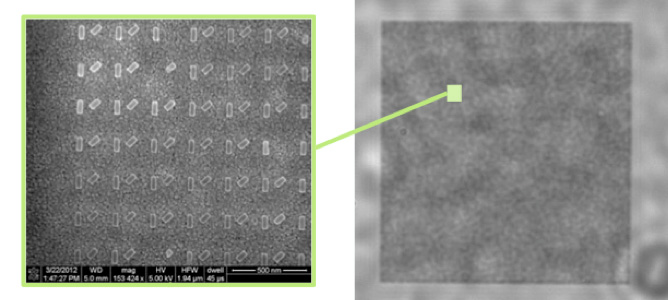Detecting chirality of biological molecules

An array of gold rods appears as a uniform thin film metamaterial with optical properties determined by the optical properties of the gold rods and their configuration.
July 2013
Many molecules in biology are chiral, meaning that they come in left-handed and right-handed forms even though they are chemically identical. Detecting these forms is important since their handedness affects how they interact. Detection is usually done with circularly polarised light, which also comes in left and right-handed forms.
A chiral optical response refers to the property of an optical material to scatter left circularly polarised light differently from right circularly polarised light. Creating a material with a strong chiral optical response is a first step towards improving the ability to detect the chirality of biological molecules.
Together with MCN, Technology Fellow, Professor Tim Davis from CSIRO has created an artificial material with a strong chiral optical response using an array of gold nanorods. The rods resonate when exposed to light, a phenomenon called surface plasmon resonance. The rods, each about 100nm long and 40nm wide, are arrayed in pairs on a glass substrate. The periodicity of the array is 250 nanometres, well below the wavelength of light. With this periodicity, the array appears as a uniform, thin film material, known as a metamaterial. Using a theory of optical resonances in gold nanorods, MCN Process Engineer, Dr. Fatima Eftekhari and Professor Tim Davis predicted an optimum chiral optical response for the metamaterial with the rod pairs oriented at 45 degrees and with the rod resonances slightly different from each other. The metamaterial was fabricated using electron beam lithography on a 30nm thick gold film on glass followed by an etching process. Optical experiments confirm that the optimum angle between the rods is 45 degrees.
The 30nm thick metamaterial shows a difference in scattering of left and right circularly polarised light of 16%, some 3000 times stronger than obtained with equivalent solutions of standard chiral materials.
The pair have shown that new optical materials can be created by designing functionality at the nanoscale. These artificial optical materials can be given properties not found in nature and have the potential for solving problems in biology and biochemistry.
The underpinning technology represents the manipulation of light – matter interactions at the nano scale. This is important for a whole range of technologies that use light, such as telecommunications, visual displays, solar energy systems and even chemical sensors. The project is currently developing optical circuits, in analogy with electrical circuits, but which are powered by light. This has the potential for exceptionally high speed data processing based on all-optical devices.


